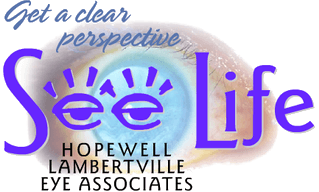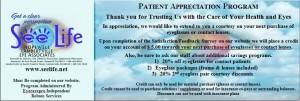President's Day : We recognize the United States' presidents as visionaries, but these leaders also had trouble seeing — literally? This Presidents' Day we recognize that "everyone" could be at risks of eye health and vision problems - as well as our leaders.
Several of our President's had significant eye problems related to trauma, ocular misalignment, vascular disease, cataracts and easily diagnosed refractive errors such as presbyopia, hyperopia, myopia and astigmatism.
Presidential Eye Health Problems
Presidents, although it may be difficult to believe, are just like you and me! While they may have more help accomplishing their day to day tasks, they still have to put their pants on one leg at a time.
Just like us, there have been presidents who have suffered from different eye problems.
Abraham Lincoln. Did you know that Honest Abe wouldn’t have been able to look at you straight in the eye, because he had strabismus? If you look closely at some photos of President Lincoln you will notice that his left eye tends to roll upwards.
Abraham "Honest Abe" Lincoln actually couldn't look a person straight in the eye, because he had strabismus. You can see this in some photos or portraits of the 16th president. Lincoln's left eye tended to roll upward, especially when he was tired or excited. News reports of his fiery 1860 presidential election debates with Stephen Douglas describe Lincoln's eye as "rolling wildly" as he spoke! His dominant right eye did most of the work of seeing, especially for near work like reading.
Lincoln's left eye was set slightly higher in his head than his right, and his left eyelid drooped a bit. When he was 10 years old Abe was kicked in the head by a horse, and may have suffered nerve damage that led to a mild paralysis of his eyelid. Lincoln also suffered from double vision (diplopia) at times.
Theodore Roosevelt. Theodore had a passion for boxing that even his presidency couldn’t stifle. During one of his many boxing matches while president, Teddy received a blow to the head that reportedly left him partially blind in his left eye. If the punch is indeed what left Roosevelt with partial vision, it probably would have been due to a detached retina.
America's 25th president, Theodore Roosevelt, was a Rough Rider and adventurer, and his move into the White House hardly slowed him down. In one of his many boxing matches while president, Roosevelt received a blow to the head that some sources say left him partially blind in his left eye. (Others say earlier injuries caused the damage.) If the tough punch was the culprit, Roosevelt's loss of sight would probably have been due to a detached retina (undiagnosed), say ophthalmologist historians. Athletes who play impact sports today can take a lesson from TR, and make sure to use protective eyewear and seek immediate medical care for any eye or head injury.
Woodrow Wilson. Seven years before Woodrow Wilson would be named the 27th president of the United States he awoke one morning to find himself nearly blind in his right eye. The previous evening he had suffered a hemorrhage in his retina while he was sleeping called a "central retinal vein occlusion". At that time there was no real treatment available other than to rest his eye for several months. It is believed that Wilson’s high blood pressure is what caused the bleed and damage. Luckily for Wilson he was able to come out of this situation with some of his vision still intact.
Ronald Reagan. Reagan’s terrible vision kept him from being able to join the military during World War 1. However, his poor vision didn’t keep him from playing football throughout high school and college. It has been documented that Reagan’s vision was so poor that he was only able to see about a 1 yard radius around him. As you can imagine, this disability lead to some issues on the field for Reagan. It has been said that during his football career he was often hit in the head with the football because he couldn’t see it coming towards him.
Jimmy Carter Fought to Eliminate Eye Disease That Plagued His Childhood
Former U.S. President Jimmy Carter was at Pfizer Headquarters in Manhattan on November 5th to honor the 15th anniversary of the International Trachoma Initiative (ITI), a non-for-profit program dedicated to eliminating the eye disease as a public health concern by 2020. Trachoma is a bacterial infection, often spread by houseflies, and it stands as the leading cause of infectious blindness in the world. Carter spoke of his experience with trachoma as a child growing up on a farm in Georgia in the 1920s and 30s. “I was always afflicted with houseflies around my eyes,” Carter said. “I had sore eyes, [which could have developed] into an infection that turns your upper eyelid inward. So every time you blink your eye, your eyelashes slash your cornea, and that causes blindness. It’s a terrible affliction that can be avoided with proper treatment.” Luckily for Carter, his mother was a nurse who always made him wash his face to rid the flies.
The Carter initiative is to protect against Trachoma was eliminated the U.S. in the late 1970s, though it remains endemic in many countries in Asia and Africa. The Carter Center has been working with ITI to improve water access, hygiene education and availability of the antibiotic Zithromax in these regions.
George Bush's wife Barbara Bush Lived a Full Life with Graves' Disease
In the days leading up to First Lady Barbara Bush’s death, at the age of 92, news reports about her condition often mentioned that she had Graves’ disease.¹⁻³ Those unfamiliar with this thyroid disorder could have been left with the impression that the disorder might have contributed to her death. That is simply not the case. When diagnosed and treated properly, Graves’ disease is not a fatal condition. Grave's Disease, a significant thyroid disorder allows fatty tissue adipose to lodge behind the eyes forcing them to protrude as well as potential can lead to partial loss of vision called an compressive optic neuropathy and condition that can be treated.
PRESIDENTIAL GLASSES

This year on President’s Day, we’re taking a step back from good furniture sales and the advantages of having a three-day weekend to explore a more frivolous — but all the while interesting — topic. In the past 245 years and 46 presidents, only three have worn glasses full-time.
THEODORE ROOSEVELT

Our 26th president resided in the White House at the turn of the 20th Century and is famously known for his gruff-ness. A statesman, conservationist, naturalist, historian, and writer — Roosevelt grew into his curious life from a sickly childhood with severe asthma, which he would later in life grow out of.
Roosevelt, for the most part, didn’t need glasses throughout his life. It wasn’t until right around the time he took office that he could be seen wearing his famous pince-nez style glasses. Similar to a monocle, pince-nez glasses don’t havethe long arms that extend to just behind the ears. Instead, the frames slightly pinch the bridge of the nose to stay on, hence the name (pince-nez being French for “nose pincer” or “nose pincher”).
In 1912, Roosevelt was saved from an assassination attempt during a speech when the bullet that struck him was slowed down by 50 pages of notes and deflected off of his steel glasses case worn in his breast pocket. Although still wounded, Roosevelt went on to give the speech (that lasted over 84 minutes).
WOODROW WILSON

Our nation’s 28th President had quite the career before he took office: from studying political philosophy at Princeton University (then known as the College of New Jersey) to later becoming a professor and president of the same university, and to then going on to be the Governor of New Jersey (not to mention writing several political books along the way). Needless to say, Wilson’s entire being seemed to have revolved around politics.
In 1906, Woodrow woke up one day to find himself unable to see out of his left eye. Upon examination, it was discovered the sudden blindness came as a result of a blood clot and hypertension. While many believed he had suffered a stroke, it was later diagnosed that he was predisposed to the hardening of arteries, as his father had been.
Since that episode, Wilson could often be seen wearing glasses. Like Roosevelt, Wilson favored pince-nez glasses, as they were popular in the era.
HARRY S. TRUMAN

Hailing from Independence, Missouri, our 33rd president took us from the final days of WWII and into the early 50s during his time in office.
Unlike Roosevelt, Truman wore glasses since his childhood — after being diagnosed with myopia (commonly known as nearsightedness). According to his biography, Harry’s mother took him to an optometrist after a Fourth of July celebration. Harry could hear the fireworks just fine, but couldn’t make out the spectacular show with his eyes.
Through his childhood and early adult life, Truman wore round, metal or acrylic framed glasses. Yet in his presidency, he would often wear frameless glasses or transparent acrylic frames.
But these three are not alone. While they are the only presidents to have worn glasses full time, several presidents in America’s history wore glasses for reading or even for fashion.
George Washington is said to have needed +3.50 corrective lenses to read in his later years, as was the case for John Adams. John F. Kennedy was often seen sporting AO Saratoga tortoise-framed shades. Lyndon B. Johnson would often switch between translucent plastic frames and half-rim frames. Ronald Reagan was the first president to wear contacts, and Bill Clinton would often need reading glasses. And our newest president, Joe Biden, has often been seen with a pair of aviator sunglasses on.
America is making history every day and our nation’s story is far from being done! With three bespectacled presidents in our past, it’ll be interesting to see who will rise to be future presidents and what eyewear styles they may be partial to.
To learn more about eye conditions and treatment call Hopewell Lambertville Eye (www.seelife.net) for an eye health examination.
Hopewell 609-466-0055 Lambertville 609-397-7020





